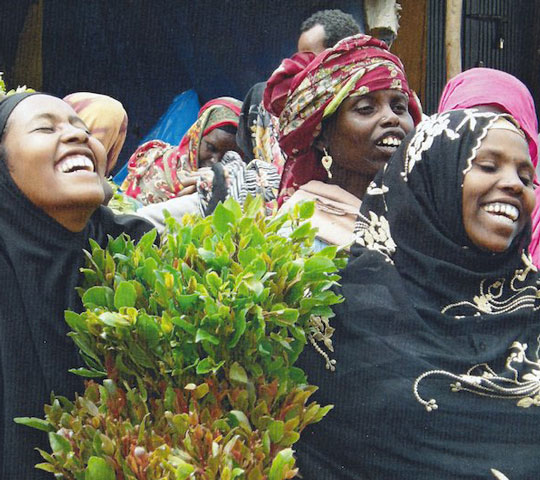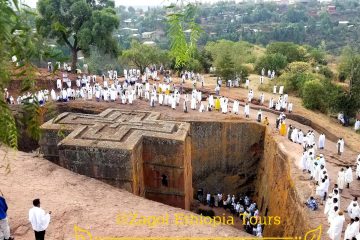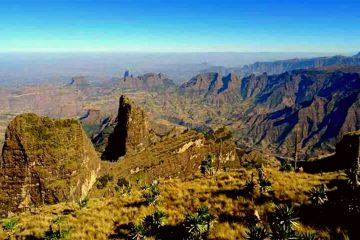Harar (sometimes spelled Harrar or Harer) is a historic walled city in eastern Ethiopia. It is located on a hilltop about 500 kilometers from Addis Ababa with an elevation of 1885 meters above sea level.
Today Harar is the administrative capital of the Harari People National Regional State. It was established by Sultan Abu Beker Mohammed in 1520 and is believed to be the forth-holiest city after Mecca, Medina and Jerusalem. It contains 82 mosques, three of which date from the 10th century and 102 shrines, which forms the largest concentration of mosques in the world.
Ahmad Ibn Ibrahim al-Ghazi, also known as “Gragn the Left-handed,” launched a war of conquest in the sixteenth century that extended its territory and even threatened the existence of the Christian Ethiopian Empire. His successor, Emir Nur ibn Mujahid, encircled the city with a wall, 4 meters high and 3.5 kilometer long with five gates. This wall, called Jugol. These walls were built between 13th and 16th centuries.
Harar Jugol has been included in the World Heritage List in 2006 by UNESCO in recognition of its cultural heritage. In 2003 the city was given a World City of Peace award by the United Nations, in honor of Harar’s unique ability to accommodate many ethnicities in a small space without conflict.
The Harari people are known for the quality of their handicrafts, including weaving, basket making and book-binding, but the houses with their exceptional interior design constitute the most spectacular part of Harar’s cultural heritage.
Spotted hyenas have been present in the walled Ethiopian city of Harar for at least 500 years, where they sanities the city by feeding on its organic refuse.
One of Harar’s main attractions is the hyena man who feeds hyenas on the outskirts of the town every night.
The hyenas became so used to being fed near the city that they started to roam the city streets at night, looking for scraps of meat thrown away. The churches were not constructed in a traditional way but rather were hewn from the living rock of monolithic blocks. Near the churches, the village of Lalibela has two storey round houses, constructed of local red stone, and known as the Lasta Tukuls. The current city of Lalibela was originally known as Roha. It was renamed after the visionary king Lalibela, member of the Zagwe Dynasty, who made these extraordinary churches.
It is a religious and pilgrimage center in Ethiopia and known to be the second Jerusalem after the capture of old Jerusalem by Muslims in 1187.
Lalibela is registered by UNESCO in 1978 and regarded as the eighth wonders of the world. Its extra ordinary religious architect and the religious rituals practiced in the area gives the city a distinctively timeless, almost biblical atmosphere. It is a high place of Ethiopian Christianity, still today a place of pilmigrage and devotion.
There are three main groups of churches – there are six churches to the north of the river Jordan: Namely Bête Medhani Alem (House of the Saviour of the World), Bête Mariam (House of Mary), Bête Maskal (House of the Cross), Bête Denagel (House of Virgins), Bête Golgotha/ Mikael (House of Golgotha /Michael), Bête Debresina; and four churches to the south of the river, bête Amanuel (House of Emmanuel), Bête Qeddus Mercoreus (House of St. Mercoreos), Bête Abba Libanos (House of Abbot Libanos), Bête Gabriel /Raphael (House of Gabriel/Raphael) and one church to the south west of river Jordan is Bête Georges (House of St. George) which is isolated from the others but connected by a system of trenches.
Around Lalibela, there are many monasteries, trekking, rich cultural and traditional attraction and eye-caching natural sceneries. Lalibela is arguably the one place in Ethiopia that no tourist should miss. The first European to see these churches was the Portuguese explorer Pêro da Covilhã (1460–1526). Portuguese priest Francisco Álvares (1465–1540), accompanied the Portuguese Ambassador on his visit to Lebna Dengel in the 1520s. He describes the unique church structures as follows:
“ I weary of writing more about these buildings, because it seems to me that I shall not be believed if I write more…I swear by God, in whose power I’m, that all I have written is the truth”.
Some of the churches that been found the surrounding area of the beautiful outstanding monolithic churches of king Lalibela which been excavated from one rock, here are some of the surrounding churches has mention.





